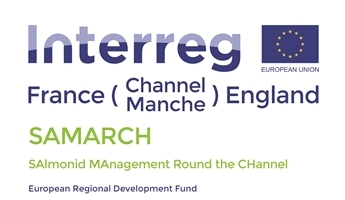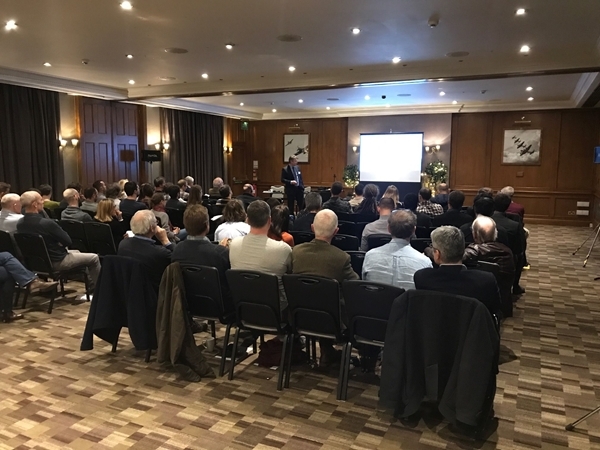
A MULTI-MILLION pound project that will provide crucial evidence to strengthen the protection of salmon and sea trout at sea has officially launched.
Launched on January 16th, the SAMARCH project will track wild salmon and sea trout through four English and French estuaries to fill the gaps in our knowledge of how quickly these fish migrate through intertidal habitat, the dangers they face there and where they go once they reach the sea.
SAMARCH (SAlmonid MAnagement Round the CHannel) is a cross-border five-year project which includes 10 partner organisations 2 - five in France and five in the UK - with the Game & Wildlife Conservation Trust the lead partner. The other partners include Institut National de Recherche Agronomique, Universities of Bournemouth, Exeter and Agrocampus Ouest, and Salmon & Trout Conservation, Environment Agency, Agence Française pour la Biodiversité, Normandie Grands Migrateurs and Bretagne Grands Migrateurs.
The project, funded by the EU’s Interreg VA France (Channel) England programme 1, will use state-of-the-art fish monitoring facilities on five rivers across the quantify the threats to salmon and sea trout in the south of England and northern France, including the Freshwater Biological Association’s River Laboratory on the River Frome, the Environment Agency’s facilities on the River Tamar, the Institut National de Recherche Agronomique’s facilities on Rivers Scorff and Oir and its specialist fish research team, as well as the Agence Française pour la Biodiversité’s facilities on River Bresle and Oir.
It will also focus on the behaviour and mortality of salmonid populations in estuaries and coastal waters to determine where losses are greatest. DNA analysis will be used to map areas in the English channel that are important for sea trout, provide new information to improve the tools used by the regulatory bodies in England and France to manage their salmon stocks.
Furthermore, the Trust is offering a reward of £50 for anyone who finds a sea trout with an electronic tag inside, giving the date and location of the recovery to tags@gwct.org.uk
The fisheries team at GWCT have started tagging sea trout this winter.

Talking at the launch to stakeholders on Tuesday in Southampton, SAMARCH project manager and head of fisheries at GWCT Dylan Roberts, pictured above, said: “It’s been a real team effort to get this project off the ground and has required patience and perseverance. “It took a total of 2.5 years to process the application, which was approved in May last year - now the hard work starts.”
“Over the past 30 years the management of salmon and sea trout has primarily focused on the freshwater environment. However, over this same period salmon survival at sea has nearly halved to only 5% and so it is imperative that we strengthen our efforts to do all we can to improve marine survival. With the use of new technology, SAMARCH will gather much needed crucial evidence to improve the protection of salmon and sea trout in estuaries and coastal waters.
“Over the next five years, through collaborating with our project partners the Environment Agency in the UK and Agence Française pour la Biodiversité in France we aim to improve the management of salmon and sea trout in Channel waters and generate new information and tools to inform current and develop new policies.
SAMARCH, which will run from 2017 to 2022, is 69% funded by the Interreg France (Channel) England programme3 which is part of the European Regional Development Fund4.
SAMARCH is launched against a background in which Atlantic salmon and sea trout have declined by around 70% 5 since the 1970s. They play a major role in coastal and river ecosystems and have a considerable economic importance through angling in Europe which is estimated to be worth as much as €1.2 billion 6 a year.
Notes to editors
The Interreg FCE Programme is a European Territorial Cooperation programme that aims to fund high quality cooperation projects in the Channel border region between France and England. It focuses on a range of specific objectives including supporting innovation, improving the attractiveness of the FCE area and developing low carbon technologies. The Programme has a total of €223 million of ERDF funds to distribute by 2023 and is managed by Managing Authority Norfolk County Council.
2. Project Partners:
Lead Partner: Game & Wildlife Conservation Trust (UK)
Institut National de Recherche Agronomique (France)
Agrocampus Ouest (France)
University of Exeter (UK)
Bournemouth University (UK)
Environment Agency (UK)
Salmon and Trout Conservation (UK)
Agence Française pour la Biodiversité (France)
Normandie Grands Migrateurs (France)
Bretagne Grands Migrateurs (France)
3. The Programme operates within a clearly defined eligible area, covering the South and East Coasts of England from Cornwall to Norfolk, and the North Coast of France from Finistère to Pas-de-Calais.
4. More information about the Programme can be found at https://interreg5a-fce.eu/.
5. Centre for Environment Fisheries & Aquaculture Science, 2014
6. Le Quesne and Selby Report, 2007
Notes to editors
The Game & Wildlife Conservation Trust – providing research-led conservation for a thriving countryside. The GWCT is an independent wildlife conservation charity which has carried out scientific research into Britain’s game and wildlife since the 1930s. We advise farmers and landowners on improving wildlife habitats. We employ more than 60 post-doctoral scientists and other research staff with expertise in areas such as birds, insects, mammals, farming, fish and statistics. We undertake our own research as well as projects funded by contract and grant-aid from government and private bodies.
For information, contact:
Eleanor Williams
Telephone: 07592 025476
Email: press@gwct.org.uk